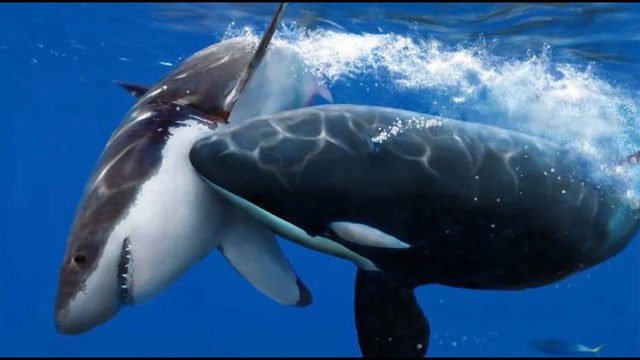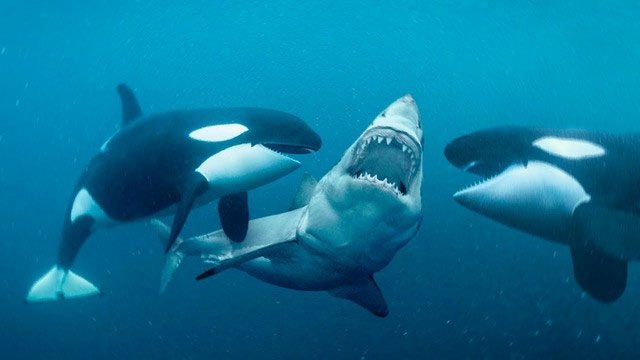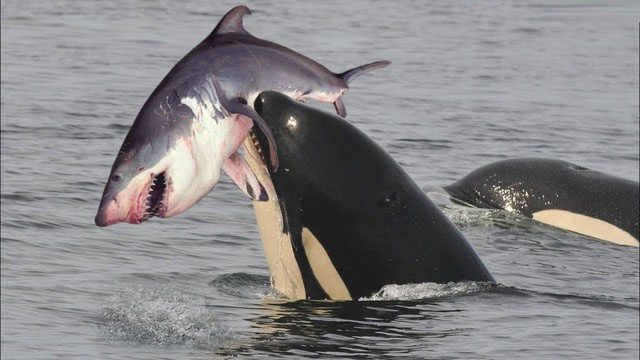In 2017, the carcass of a great white shark mysteriously appeared on the beach at Cape Town, South Africa. Even more strangely, aside from the missing liver, the other parts of its body were intact, only showing signs of decomposition over time.
To investigate further, marine animal experts quickly arrived at the scene and found bite marks on the wounds of five great white sharks, and their livers had been eaten by some creature.

Orcas attacking a great white shark.
After analysis, experts concluded that the culprits were indeed orcas. This raised the question of why orcas do not eat the flesh of great white sharks, but instead only kill and consume their livers?
When mentioning orcas, many of us might assume they are a very intelligent species. This is correct; their brains are quite large, weighing between 5 to 6 kg, and they are highly social animals capable of producing over 60 different sounds for communication. Orcas are also known for their intelligent group hunting skills, and even when facing large creatures like blue whales, they can employ task division patterns and cooperate in turns to take down blue whales.
1. Great white shark meat is unappetizing
Urea in great white sharks is often excreted through their skin, which gives their meat a urine-like odor. In ancient times, when people caught sharks, they would only cut off their fins and throw the rest of their bodies back into the sea, indicating that great white shark meat indeed has a very unpleasant flavor.

In terms of intelligence, the brain capacity and structure of great white sharks are significantly simpler than those of orcas; their IQ allows orcas to easily surpass great whites. In nature, aside from IQ, the battle between species also depends on body size. Great white sharks measure around 6 meters and weigh between 2 to 3 tons, a size considered apex in the marine ecosystem; however, this is still small compared to orcas, which measure approximately 6 to 9 meters and weigh about 3 to 6 tons.
2. Orcas have high IQs and may have developed unique eating habits
The liver of great white sharks is very nutrient-rich, with a soft and moist texture. Highly intelligent orcas may have a particular fondness for the liver of great white sharks. Compared to the African wilderness, the waters where orcas live have very few competitive rivals, giving them a wide selection of food and possibly leading to selective eating habits or the development of specific cravings.
However, upon further research, biologists found that the main reason orcas only consume the livers of great white sharks is due to the nutritional properties that this organ possesses. Similar to how humans take dietary supplements when lacking certain vitamins for health, orcas eat the livers of great whites because it is a “superfood” packed with essential vitamins they need.
The target compound that orcas aim for when consuming shark livers is a substance known as squalene. Squalene is an organic compound produced by all living beings, but only sharks concentrate this compound in their livers. Squalene is crucial for synthesizing certain chemicals in the bodies of orcas.

Orcas often attack and brutally kill sharks. They hunt in packs, destroying and dismembering sharks to eat their livers – considered the most nutritious part of the shark’s body. Observations have shown orcas only eating the tongues of whales, which is not typical behavior. They tend to eat the tongue first because it is muscular and high in protein. Additionally, orcas enjoy the tongue just as we enjoy a delicious steak.
Although shark livers are particularly tasty to orcas, they seem to be gradually expanding their palate. In South Africa, orcas have also begun targeting the hearts and testicles of great white sharks. Both organs possess unique nutritional characteristics (or may simply taste good), prompting orcas to specifically target them.
Furthermore, orcas in other parts of the world strategically target whale tongues. Just as humans prefer certain cuts of beef, orcas seem to have preferences for specific parts of whales’ bodies.


















































